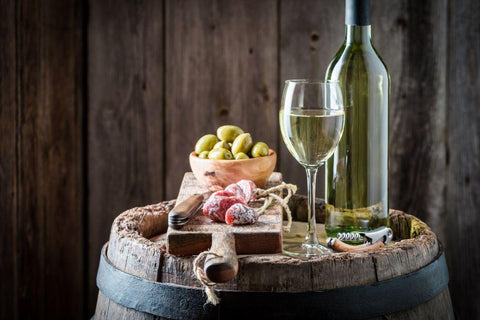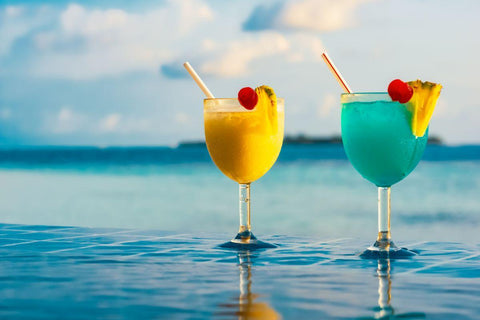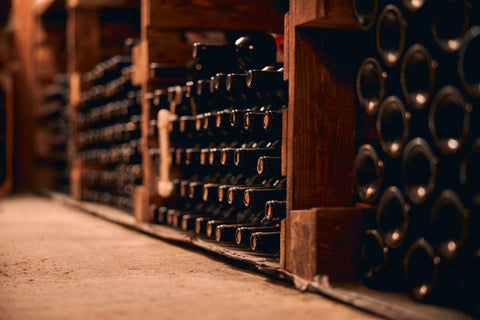What is chardonnay wine?
- Most planted wine grape
- Buttery-toasty notes
- Rich and fruit-forward in warm climates
- Lean and bright in cool climates
- Full-bodied when preserved in oak
- Unoaked variety
- Paired great with seafood and creamy dishes
- Has an ideal temperature
Chardonnay has become synonymous with white wine. Being one of the popular grapes, it comes in a range of flavors from sparkling to fruity to buttery notes. You may have been enjoying glasses of this famous white wine for dinner and parties, but you don’t know its origin or the reason for its taste.
So, what is Chardonnay wine? This article tells you all that you need to know about chardonnay: where it’s made, what flavors it has, and what you can enjoy it.
Most planted wine grape

Chardonnay is a white wine grape variety that is grown all over the world. It’s grown from a grape that shares its name. The grapes are pressed together in order to get their sugar. These are what are fermented and turned into alcohol.
It originally hails from the Burgundy region of France when Cistercian monks planted its grapes in their vineyard in 1330. Today, there are many varieties of this wine depending on where it was planted. When it arrived in California it was produced in a completely different flavor that a wider audience enjoys.
Buttery-toasty notes
The unmistakable scent of vanilla and coconut in a glass of Chardonnay is attributed to the oak aging process. However, you’ll notice a specific texture in other varieties of Chardonnay. There is an oily, creamy, and sometimes waxy texture. That’s achieved through the process of malolactic fermentation.
In this fermentation process, the wine goes through one more round of fermentation. It turns the tart malic acid to smooth lactic acid, giving it a smoother and slippier texture.
Lean and bright in cool climates

When grown in cool climates, the acidity of Chardonnay becomes more vibrant. It becomes more distinct because of its different set of fruity notes. It is rich and full-bodied with citrus notes from melons, apples, and pears.
Despite it being produced in different regions, Chardonnay is still made at its finest in Burgundy, France. There, this wine possesses a distinct yet subtle briny taste thanks to the limestone-rich soil of the region. An example is the Bouchard Pere & Fils Bourgogne Chardonnay La Vignee 2019, which features a lifted ripe peach and dried honey aroma.
Aside from Burgundy, the Chardonnay grape is also used in its neighboring region of Champagne. There, they are able to take the grape and use it to make sparkling wine. It can also be found in Loire Valley, France, and Italy.
Rich and fruit-forward in warm climates
Aside from its European origins, the Chardonnay grapes also flourished in California. When made in warmer climates, its taste becomes more tropical with notes of pineapple, papaya, mango, and guava.
It's grown in Sonoma and Santa Barbara County of California. When found in Argentina and Chile, the wine produced is more buttery with similar tropical fruit flavors.
Full-bodied when preserved in oak
The naturally high acidity of this wine makes it good for aging especially when made in cooler regions like France. The only way to achieve the full-bodied and buttery taste of Chardonnay is to age it in oak.
The wine used to be stored in barrels made of oak. These barrels will soften the wine and give it a very subtle oak flavor. Another way to age oak is through steel tanks. This allows the wine to age without imparting the influence of oak.
As the wine ages, the Chardonnay is turned into a softer wine.
An unoaked variety
Some winemakers choose to not factor in oak when making Chardonnay. When this is done, the wine has more zesty flavors. The zest depends on when the grape was harvested. Its flavor can range from the less ripe flavors of lemons to the very ripe flavor of pineapples
This unoaked variety of Chardonnay follows the same fermentation process as its oak variety. The only difference is that it's fermented inside stainless steel. This helps maintain the white grape flavors of the wine.
These are usually made in cooler climates like Sonoma, California, Western Australia, and Chile. You can try the Gossips Chardonnay 2021. This contains intensely-flavored grapes from the vines in Southern Eastern Australia.
Paired great with seafood and creamy dishes
The versatility of the Chardonnay makes it easy to pair with a variety of dishes.
Richer and full-bodied Chardonnay is best paired with hearty protein dishes with a creamy sauce. You can also enjoy it with pasta dishes like alfredo and primavera. It can also pair well with lemon squeezed onto pasta with garlic and olive oil.
When drinking a more acidic Chardonnay, pair it with seafood dishes. It will go brilliantly with white fish, salmon, raw oysters, and sauteed shrimp. However, you need to hold back on spicy sauces with more acidic varieties of the wine. It will overpower the fruit taste in the Chardonnay.
Has an ideal temperature
There are ideal temperatures for wine in order to optimize its taste. Your bottles of Chardonnay are no exception. Full-bodied Chardonnay needs to be stored at 50 - 60°F. This temperature helps bring out its rich, creamy, and butter textures.
On the other hand, unoaked Chardonnay is best stored at 45 - 50°F. Its cold temperatures help maintain its acidity and crisp, bright flavors.
Key Takeaway
And that answers the question: What is chardonnay wine It’s one of the most versatile white wines that come in many styles and flavors in different regions of the world. You can pair it with your favorite creamy dishes or even enjoy it on its own.
If you want to try this wine for yourself, peruse Ralph’s Wine & Spirits' full Chardonnay catalog. We carry Chardonnay from different regions. You can experiment with the different flavors and find your new favorite white wine and other types of wines in the Philippines.



